As loving pet parents, we often want to share everything with our furry companions, especially when they gaze up at us with those irresistible puppy eyes during mealtime. However, when it comes to human foods, what you shouldn’t feed your dog is a critically important topic. While some human foods are perfectly safe and even healthy additions to a dog’s diet, many common household items can be surprisingly toxic, even in small amounts, leading to severe illness or worse. The unfortunate truth is that pet poisonings are a significant threat, with hundreds of thousands occurring annually in the United States, and common foods are a major contributor.
Understanding the distinction between safe and harmful edibles is paramount for every dog owner. This comprehensive guide will serve as your essential resource, detailing precisely what foods you shouldn’t feed your dog, why they are dangerous, and how to safeguard your beloved pet from accidental ingestion. We’ll also briefly touch upon safe alternatives and crucial steps to take if your dog consumes something toxic. Knowledge and preparedness are your best tools in keeping your canine companion happy and healthy.
Understanding Why Certain Foods Are Dangerous for Dogs
The question of “what can dogs eat and not eat?” stems from fundamental physiological differences between humans and canines. Dogs’ digestive systems and metabolic processes are distinct from our own, allowing them to process some substances very differently. What might be harmless for a human can be profoundly dangerous for a dog.
A prime example is chocolate. While humans can metabolize theobromine and caffeine relatively quickly, dogs process these compounds much slower. This slower metabolism means that these substances can rapidly accumulate to toxic levels in their system, potentially becoming fatal. Similarly, while you might enjoy cherries, the cyanide found in their pits, stems, and leaves can be problematic if ingested in large quantities by your dog. Even the pits themselves can cause digestive upset and blockages, making them best avoided entirely.
It’s also crucial to understand that food toxicity isn’t a one-size-fits-all issue. A dog’s size, breed, and underlying health conditions can significantly influence their susceptibility and the severity of their reaction to a toxic food. For instance, smaller breeds are generally more vulnerable due to their lower body weight. This is why consulting your veterinarian is always the best course of action if you have any questions about specific foods or suspect your dog has ingested something harmful.
For a deeper dive into safe food options, you can explore our guide on what food is safe to feed dogs.
Comprehensive List of Foods You Shouldn’t Feed Your Dog
Many common household foods pose a significant risk to dogs, ranging from digestive upset to life-threatening toxicity. It’s vital for every dog owner to be aware of what you shouldn’t feed your dog. While this list covers the most common dangers, it is not exhaustive, so always err on the side of caution and consult your vet if unsure.
1. Alcohol
Due to their smaller body size and different metabolism, alcohol affects dogs much more intensely and dangerously than humans. Even minimal amounts of alcohol can cause significant harm. The smaller your dog, the more dangerous even a tiny sip can be. Symptoms of alcohol poisoning in dogs mirror those in humans, including vomiting, breathing difficulties, disorientation, coma, and in severe cases, even death.
 A small glass of clear alcoholic beverage with ice cubes.
A small glass of clear alcoholic beverage with ice cubes.
2. Apple, Apricot, Cherry, & Plum Seeds/Pits
While the fleshy part of apples is safe for dogs, the core and apple seeds are not. Apple seeds contain cyanide, which is toxic. Although small amounts might not cause immediate issues, it’s safest to avoid the core and seeds entirely. Similarly, apricot, cherry, peach, and plum seeds and pits must be strictly avoided. These fruit pits also contain cyanide, which can lead to severe symptoms such as vomiting, irregular heartbeat, seizures, coma, and even death, by preventing red blood cells from carrying oxygen efficiently.
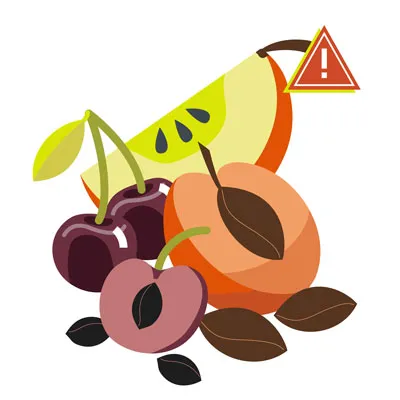 Close-up of apple slices and a few apricot halves with seeds.
Close-up of apple slices and a few apricot halves with seeds.
3. Avocado
Avocados are not a suitable food choice for dogs. They contain a fungicidal toxin called persin, which can cause vomiting and diarrhea in some dogs, though more severe reactions are rare. However, the large pit of an avocado poses a serious choking hazard and can cause a gastrointestinal obstruction if swallowed whole, necessitating emergency veterinary intervention. It’s best to steer clear of this fruit for your dog’s safety.
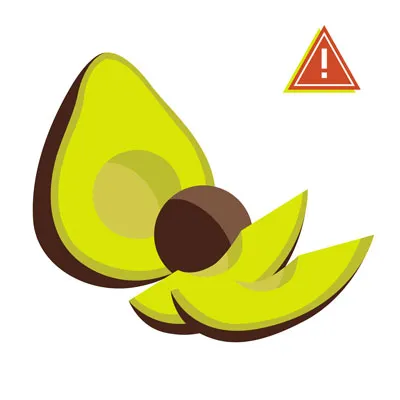 A sliced avocado showing its green flesh and large pit.
A sliced avocado showing its green flesh and large pit.
4. Broccoli
Broccoli contains isothiocyanates, compounds that can be harmful to pets in very large doses. While tiny, occasional amounts of broccoli might be tolerated, it’s generally best to avoid it when so many other healthy and safe vegetables are available. Furthermore, the fibrous stalks of broccoli can pose a choking risk for dogs, or cause an obstruction if swallowed improperly.
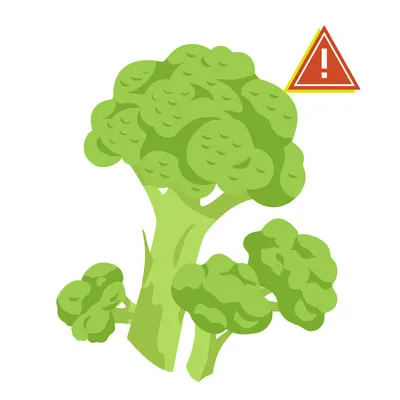 Several florets of fresh, green broccoli.
Several florets of fresh, green broccoli.
5. Caffeine & Coffee Grounds
Caffeine, found in coffee, tea, energy drinks, and some medications, contains methylxanthines. These stimulants can cause severe and potentially fatal symptoms in dogs, including diarrhea, vomiting, seizures, and an irregular heartbeat. Even accidental ingestion of coffee grounds or high-caffeine beverages can cause a dog’s heart to race, leading to tremors, arrhythmia, difficulty breathing, and other life-threatening symptoms.
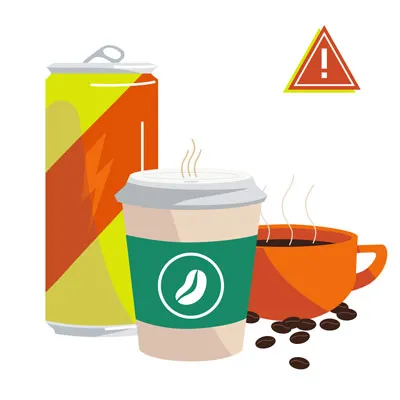 A cup of coffee next to scattered coffee beans and ground coffee.
A cup of coffee next to scattered coffee beans and ground coffee.
6. Chicken & Turkey Skin, Ham, & Other Fatty Cuts of Meat
When considering what you shouldn’t feed your dog from your dinner plate, extremely fatty cuts of meat, such as chicken or turkey skin, or ham, are high on the list. These items are detrimental to dogs due to their high fat content, which can trigger acute pancreatitis—a painful and life-threatening inflammatory condition of the pancreas that often requires intensive veterinary care.
Additionally, avoid giving cooked turkey or chicken bones to your dog. Cooked bones become brittle and can splinter easily, leading to internal injuries such as obstruction of the bowels, damage to the stomach or intestines, or even perforation, which can result in a fatal abdominal infection. For specific concerns about meat, refer to our guide on what meat dogs should not eat.
 Pieces of cooked meat, including chicken skin and ham, on a plate.
Pieces of cooked meat, including chicken skin and ham, on a plate.
7. Chocolate
Chocolate toxicity is one of the most widely known dangers for dogs, and for good reason. It contains a stimulant called theobromine, which dogs metabolize much slower than humans. The darker and more bitter the chocolate, the higher its concentration of theobromine, making dark chocolate and baking chocolate the most dangerous forms. Chocolate also contains caffeine, and some sugar-free varieties may contain xylitol, both of which are highly toxic to dogs.
Ingestion of chocolate can lead to a range of symptoms, including hyperactivity, vomiting, diarrhea, pancreatitis, abnormal heart rhythms, and seizures. If your dog ingests any amount of chocolate, no matter how small, immediate veterinary attention is crucial.
 Various types of chocolate, including dark chocolate bars and chocolate chips.
Various types of chocolate, including dark chocolate bars and chocolate chips.
8. Grapes & Raisins
Grapes and raisins are incredibly dangerous for dogs and can cause acute kidney failure, even in small amounts. The exact toxic component, tartaric acid, has been identified as the culprit, directly harming your dog’s kidneys. Even a few pieces can wreak havoc. Symptoms of grape or raisin poisoning include vomiting, diarrhea, loss of appetite, lethargy, abdominal pain, increased thirst, and changes in urination (from excessive to complete absence of urine production).
 A bunch of red grapes and a small pile of raisins.
A bunch of red grapes and a small pile of raisins.
9. Macadamia Nuts, Almonds, & Pistachios
Macadamia nuts are particularly toxic to dogs, causing painful symptoms such as weakness, tremors, depression, vomiting, and hyperthermia (overheating). The precise mechanism of their toxicity is not fully understood, but even as few as six nuts can cause severe poisoning in a small dog.
While macadamia nuts are the most perilous, other nuts like almonds and pistachios should also be avoided, primarily because they can be choking hazards. They also contain high levels of fat, which can lead to pancreatitis. Flavored or spiced nuts often contain additional harmful ingredients like salt, garlic, or onion powder.
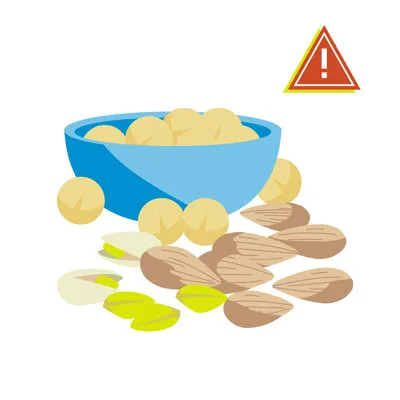 A small bowl filled with macadamia nuts, almonds, and pistachios.
A small bowl filled with macadamia nuts, almonds, and pistachios.
10. Milk & Dairy Products
The safety of milk and other dairy products for dogs varies. Many dogs are lactose intolerant, meaning they lack the enzyme necessary to properly digest lactose, the sugar in milk. Consuming dairy can lead to digestive upset, including diarrhea and gas.
High-fat dairy products like ice cream are particularly bad due to their high sugar and fat content, which can also contribute to pancreatitis. Instead of ice cream, consider freezing bites of safe fruits for a healthy, cool treat. Small quantities of lower-fat cheeses might be acceptable for some dogs, but always proceed with caution and consult your veterinarian.
 A glass of milk and a cheese slice.
A glass of milk and a cheese slice.
11. Mushrooms
It’s generally safest to completely avoid feeding your dog any mushrooms. While some commercial white button mushrooms might be considered safe in very small, washed, cooked quantities, it’s almost impossible for an owner to distinguish between harmless and highly toxic wild mushroom species. Wild mushrooms can contain a variety of toxins that may cause severe symptoms such as kidney and liver failure, vomiting, diarrhea, hallucinations, and damage to red blood cells. Always choose a different, unequivocally safe treat.
 A variety of fresh, whole mushrooms, including white and brown types.
A variety of fresh, whole mushrooms, including white and brown types.
12. Nutmeg & Cinnamon
When it comes to spices, nutmeg is definitely what you shouldn’t feed your dog. This spice contains myristicin, a compound that can cause severe vomiting, disorientation, increased heart rate, and even hallucinations in dogs, especially in high doses or for smaller breeds. Even if your dog begs for a nutmeg-spiced treat, resist the temptation and call your vet if any amount is ingested.
Cinnamon, while not considered truly toxic, should also be avoided. It can irritate a dog’s mouth and digestive tract, leading to discomfort. In larger quantities, it can also potentially cause a drop in blood sugar, which can have serious health implications for your pup.
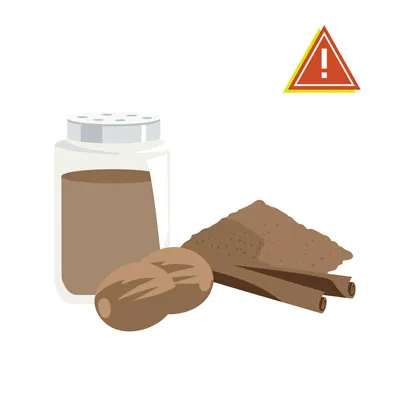 A small pile of ground nutmeg next to whole cinnamon sticks.
A small pile of ground nutmeg next to whole cinnamon sticks.
13. Onions, Garlic, Chives, & Leeks
These common culinary herbs, all belonging to the Allium family, are highly toxic to dogs. Onions, garlic, chives, and leeks contain compounds called sulfoxides and disulfides. These substances can damage a dog’s red blood cells, leading to a serious condition known as hemolytic anemia, which can be fatal. Onion and garlic powders, often found in many prepared foods (even baby food), are equally dangerous, so meticulous label-reading is essential.
All plants in the Allium family pose a risk to dogs and cats. Certain Japanese breeds, such as Akitas and Shiba Inus, are known to be particularly sensitive, but these plants are dangerous for all dogs. Symptoms may include lethargy, weakness, pale gums, elevated heart rate, and red or brown urine.
 Whole onions, garlic cloves, chives, and le leeks on a cutting board.
Whole onions, garlic cloves, chives, and le leeks on a cutting board.
14. Salt
Excessive salt intake can be very dangerous for dogs. Too much salt can disrupt the fluid balance in a dog’s cells, leading to sodium ion poisoning. This can manifest as tremors, seizures, vomiting, diarrhea, depression, and even coma. Whether it’s from highly salted snacks like potato chips, or non-food items like rock salt or homemade play dough, always keep salty items out of your dog’s reach. Fresh, clean water should always be readily available.
 A small pile of white salt crystals.
A small pile of white salt crystals.
15. Spicy Food
Spicy foods are definitely what you shouldn’t feed your dog. While not always directly toxic, the capsaicin found in chili peppers and other spicy ingredients can cause significant gastrointestinal upset, including severe vomiting, diarrhea, and stomach ulcers. This can be incredibly painful and distressing for your dog, and potentially lead to costly emergency veterinary visits. Stick to bland, safe treats instead.
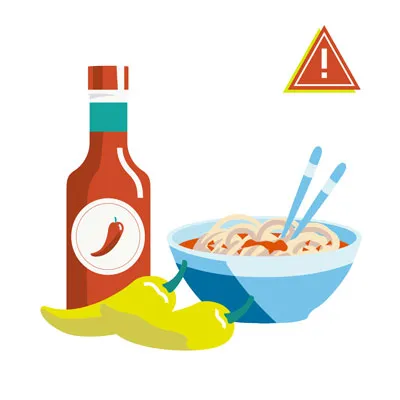 A bowl of red chili flakes and fresh red chili peppers.
A bowl of red chili flakes and fresh red chili peppers.
16. Sugar-Free Gum & Candy (Xylitol)
Xylitol is an artificial sweetener found in a growing number of human products, including sugar-free gum, candies, mints, sugar-free baked goods, toothpaste, and even some peanut butters. For dogs, xylitol is profoundly toxic. It causes a rapid and severe drop in blood sugar (hypoglycemia), leading to symptoms like weakness, disorientation, vomiting, tremors, and seizures. In some cases, it can also cause acute liver failure, which is often fatal. Even a small amount, like the xylitol in five pieces of gum, can be lethal to a 65-pound dog. This is a crucial item on the list of what you shouldn’t feed your dog.
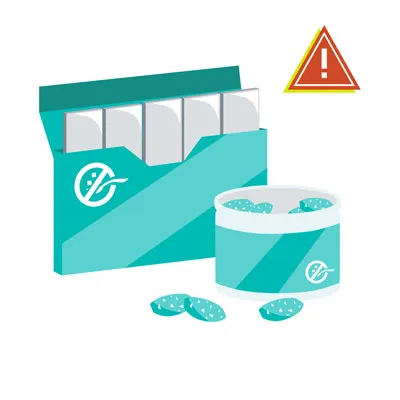 Various sugar-free candies and chewing gum.
Various sugar-free candies and chewing gum.
17. Tomatoes & Raw Potatoes
These vegetables fall into a “safe in some forms, unsafe in others” category. A fully ripened red tomato is generally considered safe for dogs in moderation. However, the green parts of the tomato plant, including the leaves, stems, and unripened green tomatoes, contain solanine, a glycoalkaloid toxin that can be harmful to dogs.
Raw potatoes also contain solanine. While baked or boiled potatoes without any additives are generally safe in small amounts, raw potatoes should be avoided. Symptoms of solanine poisoning can include gastrointestinal upset, lethargy, weakness, and confusion.
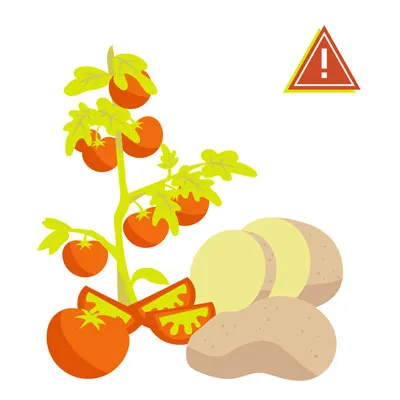 Fresh red tomatoes and raw potatoes.
Fresh red tomatoes and raw potatoes.
18. Tobacco
Tobacco products, including cigarettes, cigars, chewing tobacco, and nicotine-containing e-liquids or patches, are highly dangerous for dogs. Nicotine is a potent toxin that can cause a variety of severe symptoms, including vomiting, diarrhea, rapid or labored breathing, agitation, abnormal heart rate, wobbliness, weak muscles, high or low blood pressure, tremors, and seizures.
More significant or frequent exposure can lead to blue gums and coma, and ultimately be fatal. Dogs are curious and may ingest tobacco accidentally from discarded cigarettes or ashtrays. If your dog gets into any tobacco product, immediate veterinary intervention is critical.
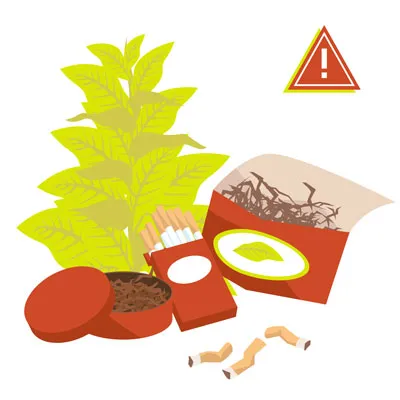 A few cigarettes and loose tobacco.
A few cigarettes and loose tobacco.
19. Yeast & Raw Dough
Yeast and raw dough are extremely unsafe for dogs for two primary reasons. Firstly, raw dough can expand significantly in a dog’s warm stomach, causing severe pain, bloating, and potentially life-threatening gastric dilation-volvulus (GDV) or stomach rupture. Secondly, the yeast and sugar in raw dough can ferment, producing alcohol. This leads to alcohol toxicity, which, as previously mentioned, can be fatal and requires immediate medical attention.
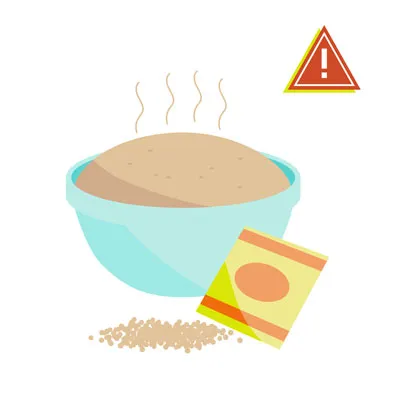 A bowl of raw dough with a packet of yeast.
A bowl of raw dough with a packet of yeast.
20. Raw Meat
You shouldn’t feed your dog raw or undercooked meat. While some advocates promote raw diets, they carry significant risks. Raw meat can harbor dangerous bacteria such as Salmonella, E. coli, and Listeria, which can cause severe gastrointestinal illness in dogs (and can also be transmitted to humans). Additionally, raw bones within meat can pose choking hazards or cause internal damage if splintered. Thoroughly cooking meat eliminates these bacterial risks and softens bones, making them safer (though cooked bones should still generally be avoided as they can splinter).
 A piece of raw red meat.
A piece of raw red meat.
21. Rhubarb
Rhubarb is a plant commonly used in human desserts like pies, but it is not safe for pets. Its leaves contain soluble calcium oxalate crystals. If ingested in large enough quantities, these crystals can bind with calcium in the body, causing a dangerous drop in calcium levels and potentially leading to acute renal (kidney) failure. Symptoms can include tremors, weakness, excessive drooling, bloody urine, changes in thirst and urination, and vomiting.
 Fresh rhubarb stalks with large green leaves.
Fresh rhubarb stalks with large green leaves.
22. Star Fruit
Similar to rhubarb, star fruit also contains soluble calcium oxalate crystals. Therefore, this tropical fruit is another item what you shouldn’t feed your dog. Ingesting star fruit can lead to similar adverse effects as rhubarb, including kidney damage, especially in dogs with pre-existing kidney conditions. It’s best to keep your dog away from this exotic fruit.
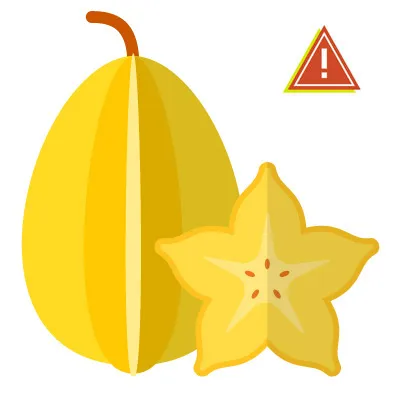 A sliced star fruit showing its distinctive shape.
A sliced star fruit showing its distinctive shape.
23. Flavored Water and Seltzer Water
When offering your dog water, always opt for fresh, plain, clean water. Flavored and seltzer (carbonated) waters can contain added ingredients that are dangerous for pups, including artificial sweeteners (like xylitol), high levels of sugar, or excessive salt. While plain seltzer water might be deemed acceptable in very small, urgent situations, it can often lead to gas and bloating, causing discomfort. It’s unequivocally best to stick to unadulterated water for your canine companion.
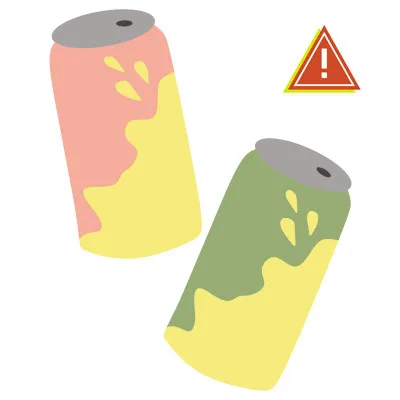 A glass of seltzer water with lemon slices and ice.
A glass of seltzer water with lemon slices and ice.
Safe Foods Your Dog Can Enjoy
While the list of what you shouldn’t feed your dog might seem extensive, there’s also a wide variety of human foods that are perfectly safe and even beneficial for your canine friend in moderation. Offering these as occasional treats can provide nutritional benefits and enjoyable variety.
For a comprehensive list and detailed information on safe human foods for dogs, refer to our dedicated article: what is good for dogs to eat. This article offers a more in-depth exploration, but here’s a brief overview of some popular and healthy options:
1. Apples, Oranges, & Bananas
The fleshy parts of apples (without the core and seeds) are excellent sources of vitamins and fiber. Always remove the core and seeds. Oranges are safe in small amounts and provide Vitamin C, but remove the peel and seeds. Bananas, without the peel, are a great source of potassium and vitamins, also safe in moderation.
 Various fruits including whole apples, oranges, and bananas.
Various fruits including whole apples, oranges, and bananas.
2. Blueberries & Blackberries
These berries are superfoods for dogs! Blueberries, in particular, are packed with antioxidants, fiber, phytochemicals, and Vitamin C, all contributing to your pup’s overall health. Blackberries offer similar benefits. They make delicious and healthy treats.
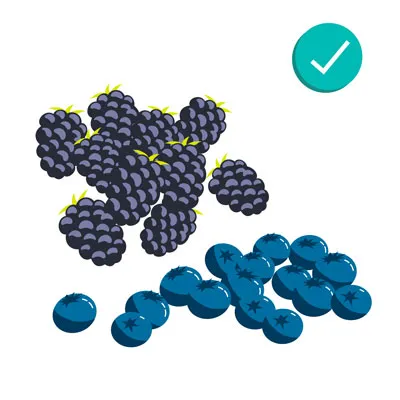 Fresh blueberries and blackberries in small bowls.
Fresh blueberries and blackberries in small bowls.
3. Cantaloupe, Mango, Peaches, Pears, Pineapples, & Watermelons
Many fruits offer safe and tasty treats for dogs. Cantaloupe is a fantastic choice, rich in vitamins. Watermelon, without the rinds and seeds (including the pale seeds in “seedless” varieties), is hydrating and refreshing, especially on a warm day. Mangoes, peaches, pears, and pineapples are also safe in moderation, but ensure all seeds, pits, and cores are removed before serving. For specific fruit concerns, especially regarding younger dogs, review what fruits can puppies not eat.
 Assortment of sliced fruits including cantaloupe, mango, and pineapple.
Assortment of sliced fruits including cantaloupe, mango, and pineapple.
4. Carrots, Cucumber, and Celery
The “three C’s” — carrots, cucumbers, and celery — are excellent, low-calorie options, especially for overweight dogs. Bite-sized carrot pieces provide a satisfying crunch and are rich in vitamins. Celery offers a similar crunch and can even help freshen breath. Cucumber slices are packed with vitamins and minerals while being very low in carbohydrates and fats.
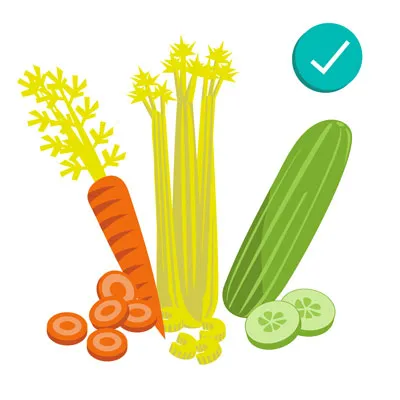 Fresh carrots, cucumber slices, and celery sticks.
Fresh carrots, cucumber slices, and celery sticks.
5. Cheese
While dairy can be problematic for some, small amounts of cheese are generally acceptable for dogs who are not lactose intolerant. Opt for lower-fat varieties like mozzarella as an occasional treat, and always monitor your dog for any signs of digestive upset. Consult your veterinarian for the best type and portion size.
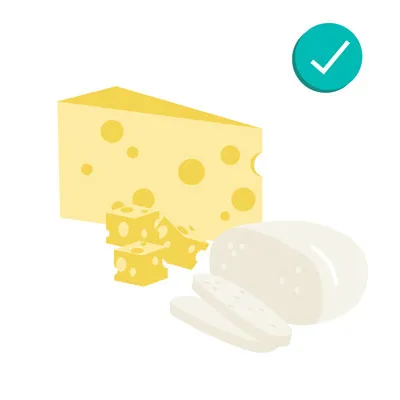 A block of cheese and a few cheese slices.
A block of cheese and a few cheese slices.
6. Eggs
Fully cooked eggs are a fantastic and highly digestible source of protein for dogs. Scrambled or hard-boiled eggs, served plain, can be a great way to soothe an upset stomach or simply provide a nutritious treat. Ensure they are cooked thoroughly to eliminate the risk of salmonella.
 A basket of eggs and a cracked egg in a bowl.
A basket of eggs and a cracked egg in a bowl.
7. Peanuts, Peanut Butter, and Cashews
Peanuts and cashews (unsalted, unflavored) are safe in small quantities, but due to their high fat content, they should only be given sparingly. Peanut butter is a popular treat and a good source of protein for dogs in moderation. Always choose unsalted, plain varieties and, crucially, avoid any peanut butter that contains xylitol, which is highly toxic to dogs.
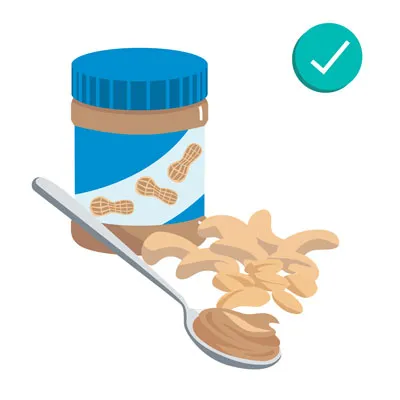 A bowl of peanuts, a jar of peanut butter, and a few cashews.
A bowl of peanuts, a jar of peanut butter, and a few cashews.
8. Popcorn and Corn
Air-popped, unsalted, and unbuttered popcorn can be a fun treat. Always check carefully to ensure there are no unpopped kernels, which can be a choking hazard. Similarly, corn (removed from the cob) is safe when served plain, without butter, salt, or spices. Avoid corn on the cob as the cob itself can cause intestinal obstructions.
 A bowl of popcorn and fresh corn on the cob.
A bowl of popcorn and fresh corn on the cob.
9. Coconut and Honey
In small amounts, coconut (including coconut milk and coconut oil) is generally fine for dogs. It contains lauric acid and may even offer benefits for skin and coat health. However, some dogs might experience mild digestive upset from fresh coconut or coconut milk, so introduce it cautiously. Always avoid coconut water (which can be high in potassium) and the fibrous shell, which poses a choking risk. Honey, in moderation, is also safe and contains various vitamins and minerals beneficial for your pup.
 A sliced coconut and a jar of honey.
A sliced coconut and a jar of honey.
10. Shrimp and Fish
Plain, fully cooked shrimp is a healthy, low-fat protein source for dogs. Ensure the shell, head, tail, and legs are removed, and it’s free from seasoning, salt, or butter. Fish, particularly salmon and sardines, is also permissible when plain, fully cooked, and boneless. Limit fish to no more than twice a week to avoid mercury accumulation. Plain, canned tuna (packed in water, not oil, and low in sodium) is also safe in moderation.
 Cooked shrimp and a piece of cooked fish.
Cooked shrimp and a piece of cooked fish.
11. Turkey
Cooked turkey meat, when free from skin, fat, and bones, is a healthy and safe source of lean protein for dogs. Offer small, plain bites as a delicious treat. Always avoid seasoned or salted turkey, and never give cooked turkey bones, which can splinter.
 A cooked turkey breast slice.
A cooked turkey breast slice.
12. Grains, Wheat, and Quinoa
Grains like wheat, when cooked and in small quantities, are generally fine for dogs who don’t have sensitivities. Quinoa is a particularly healthy option, often used as a filler in high-quality dog foods, providing protein and fiber. Always monitor for any signs of allergic reactions when introducing new grains to your dog’s diet.
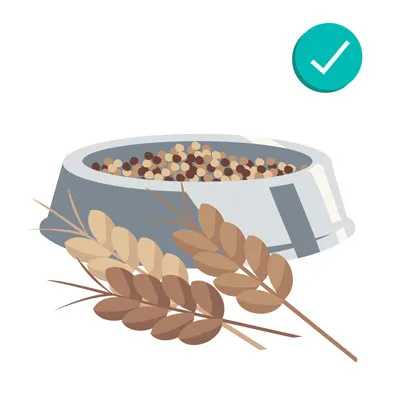 Various grains, including wheat kernels and cooked quinoa.
Various grains, including wheat kernels and cooked quinoa.
13. Green Beans
Green beans are a popular and excellent choice for dogs. They are safe, tasty, and healthy, whether served raw, steamed, or from a can (ensure canned varieties are plain with no added salt or spices). They are low in calories and high in fiber and vitamins, making them a great treat or a supplement for dogs needing to manage their weight. Cut them into bite-sized pieces to prevent choking.
 A pile of fresh green beans.
A pile of fresh green beans.
This distinction between what you should and shouldn’t feed your dog is crucial for their well-being. For a broader perspective on safe human foods, consider our resource on what human food can dogs not have which delves into both safe and unsafe options.
Dogs Most at Risk if They Consume Toxic Foods
While it’s critical to prevent any dog from ingesting toxic foods, certain dogs face a higher risk and more severe consequences if they do. Understanding these risk factors can help you be even more vigilant.
- Small Breeds vs. Large Breeds: Smaller dogs are significantly more vulnerable to toxic foods due to their lower body weight. A small amount of a toxic substance that might cause mild symptoms in a large dog could be lethal for a tiny breed. This is especially true for substances like chocolate and xylitol.
- Puppies: Young dogs have less developed digestive and immune systems, making them more susceptible to adverse reactions from certain substances, including bacteria sometimes found in raw foods. Their natural curiosity also makes them more prone to exploring and ingesting inappropriate items.
- Elderly Dogs: Older dogs often have compromised immune systems or pre-existing health conditions (like kidney disease, heart issues, or diabetes) that can exacerbate the effects of toxic foods, putting them at a higher risk for severe complications.
- Dogs with Pre-existing Conditions: Dogs suffering from chronic illnesses such as diabetes, kidney disease, liver problems, or pancreatitis are at a much greater risk. Their bodies may be less equipped to process toxins or may react more severely to dietary upsets, leading to life-threatening exacerbations of their existing conditions.
Essential Strategies to Prevent Your Dog from Eating Harmful Foods
Even with the best intentions, accidents can happen. However, implementing proactive strategies can significantly reduce the risk of your beloved pup getting into foods that you shouldn’t feed your dog.
- Store Foods Out of Reach: The simplest and most effective prevention method is to ensure that all potentially toxic foods are stored securely and out of your dog’s reach. This means keeping dangerous items on high shelves, in locked pantries, or in containers that your dog cannot open. Never leave toxic foods unattended on countertops or low tables.
- Avoid Feeding Dogs from Your Plate: It can be tempting to share a bite, but feeding your dog directly from your plate or in the kitchen while you’re cooking creates an association that can lead to begging and opportunistically snatching food. It’s safest to only give your pup treats that are specifically formulated and approved for dogs.
- Educate Family Members and Guests: Ensure everyone in your household, including children, and any guests are aware of the rules regarding feeding your dog. Emphasize that no matter how much your dog begs or how innocent it seems, they should never sneak human food to your pet without explicit permission and knowledge of what is safe.
- Be Extra Careful During Holidays and Gatherings: Holidays and social events often involve an abundance of rich, unfamiliar, and potentially toxic human foods. The commotion and distraction of these times can make it easy to let your guard down. Be extra cautious: secure food waste, keep serving dishes away from curious noses, and alert guests about your dog’s dietary restrictions.
Despite all precautions, if your dog does consume something toxic, being prepared can make all the difference. Keep contact information readily available for your regular veterinarian, a 24/7 emergency veterinary clinic, and a pet poison control hotline (like the ASPCA Animal Poison Control Center or Pet Poison Helpline).
What to Do If Your Dog Consumes Something Toxic
Recognizing the signs and acting quickly are paramount if your dog eats something what you shouldn’t feed your dog. The speed of response can significantly impact your dog’s outcome.
Firstly, you need to be familiar with the common symptoms of food toxicity. These can vary widely depending on the specific substance ingested, the amount, and your dog’s individual sensitivity. General symptoms might include:
- Gastrointestinal Distress: Vomiting, diarrhea (possibly bloody), loss of appetite, excessive drooling, abdominal pain, or a bloated, hard stomach (which can indicate a life-threatening condition like bloat or gastric torsion).
- Neurological Signs: Lethargy, weakness, disorientation, tremors, seizures, agitation, restlessness, or coma.
- Cardiovascular Issues: Abnormal heart rate (too fast or too slow), difficulty breathing, pale or blue gums.
- Other Symptoms: Increased thirst or urination, changes in urine color, muscle weakness, or overall distress.
If you observe any of these symptoms or suspect your dog has ingested a toxic food, do the following immediately:
- Call Your Veterinarian or Poison Control Right Away: Do not wait for symptoms to worsen. Timing is crucial. Early intervention often leads to more successful treatments and shorter hospitalization periods. Have the emergency contact numbers readily accessible.
- Be Ready with Important Information: When you call, be prepared to provide as much detail as possible:
- The exact type of food your dog ate.
- The approximate amount consumed.
- The estimated time of ingestion.
- Any symptoms you have observed.
- Your dog’s breed, age, weight, and any pre-existing health conditions.
- Avoid Home Remedies Unless Advised: Do not attempt to induce vomiting or administer any home remedies without explicit instructions from your veterinarian or poison control expert. Depending on the substance ingested, inducing vomiting can sometimes be more harmful (e.g., if the substance is corrosive or if your dog is already showing neurological signs). Your vet will provide specific guidance based on the situation.
Conclusion
Navigating the world of human foods and understanding what you shouldn’t feed your dog is an essential part of responsible pet ownership. While it can be challenging to keep track of every potentially harmful item, this guide provides a solid foundation for protecting your furry friend from common household dangers. Your vigilance, combined with a clear understanding of toxic foods, prevention strategies, and swift action in emergencies, are your best tools to safeguard your dog’s health.
Remember, dogs are often driven by curiosity and instinct, sometimes leading them to eat things they shouldn’t. The good news is that there are also plenty of delicious, safe, and healthy human foods that your dog can enjoy as treats. Explore our list of safe options and find what your dog loves, ensuring they are always given in appropriate portions and preparation. When in doubt about any food, always prioritize your dog’s safety and consult with your veterinarian. Their expert advice is invaluable in maintaining your beloved companion’s optimal health and well-being.
References
- “Top 10 dog poisons,” Hilary Parker (5/2023), WebMD, https://www.webmd.com/pets/dogs/top-10-dog-poisons
- “What happens if a dog eats chocolate?” (10/2023), Colorado State University, https://vetmedbiosci.colostate.edu/vth/animal-health/why-is-chocolate-bad-for-dogs/
- “Fruits and vegetables dogs can or can’t eat,” (3/2024), American Kennel Club, https://www.akc.org/expert-advice/nutrition/fruits-vegetables-dogs-can-and-cant-eat/
- “What to do if your dog drinks alcohol,” Jerry Klein (7/2023), American Kennel Club, https://www.akc.org/expert-advice/vets-corner/is-alcohol-dangerous-for-dogs/
- “Can dogs eat apples?” Hector Joy (12/2022), PetMD, https://www.petmd.com/dog/general-health/can-dogs-eat-apples
- “Can dogs eat plums?” Katie Koschalk (7/2023), Chewy, https://be.chewy.com/nutrition-pet-diet-tips-can-dogs-eat-plums/
- “Avocado (Persea spp) Toxicosis in Animals,” Cristine Hayes (9/2024), Merck Veterinary Manual, https://www.merckvetmanual.com/toxicology/food-hazards/avocado-persea-spp-toxicosis-in-animals
- “People foods to avoid feeding your pets,” (n.d.), ASPCA, https://www.aspca.org/pet-care/animal-poison-control/people-foods-avoid-feeding-your-pets
- “People foods dogs can and can’t eat,” (3/2024), American Kennel Club, https://www.akc.org/expert-advice/nutrition/human-foods-dogs-can-and-cant-eat/
- “Can dogs eat nuts?” Amanda Ardente (1/2023), PetMD, https://www.petmd.com/dog/nutrition/can-dogs-eat-nuts
- “Can dogs drink milk?” Sandra C. Mitchell (1/2024), PetMD, https://www.petmd.com/dog/nutrition/can-dogs-drink-milk
- “Can dogs have nutmeg?” Barri J. Morrison (11/2023), PetMD, https://www.petmd.com/nutmeg-safe-dogs
- “Onion, garlic, chive, and leek poisoning in dogs,” Renee Schmid et al. (2024), VCA Animal Hospitals, https://vcahospitals.com/know-your-pet/onion-garlic-chive-and-leek-toxicity-in-dogs
- “Can dogs eat tomatoes?” Anna Burke (10/2024), American Kennel Club, https://www.akc.org/expert-advice/nutrition/can-dogs-eat-tomatoes/
- “Can dogs eat potatoes?” Katherine Ripley (11/2023), American Kennel Club, https://www.akc.org/expert-advice/nutrition/can-dogs-eat-potatoes/
- “What to do if your dog eats a cigarette butt,” (6/2023), American Kennel Club, https://www.akc.org/expert-advice/health/dog-ate-cigarette-butt/
- “Dough & dogs: Why it’s bad and what you can do,” Lisa Goldstein (7/2024), Preventive Vet, https://www.preventivevet.com/dogs/dough-is-toxic-to-dogs
- “Rhubarb,” (n.d.), Pet Poison Helpline, https://www.petpoisonheline.com/poison/rhubarb/
- “Can dogs drink carbonated water?” Heather Logue (n.d.), Rover, https://www.rover.com/blog/can-dogs-drink-carbonated-water/
- “What fruits can dogs eat?” Ellen Malmanger (2/2024), PetMD, https://www.petmd.com/dog/nutrition/what-fruits-can-dogs-eat
- “Can dogs have green beans?” Anna Burke (8/2022), American Kennel Club, https://www.akc.org/expert-advice/nutrition/can-dogs-have-green-beans/
- “About pet food safety,” (4/2024), CDC, https://www.cdc.gov/healthy-pets/about/pet-food-safety.html
